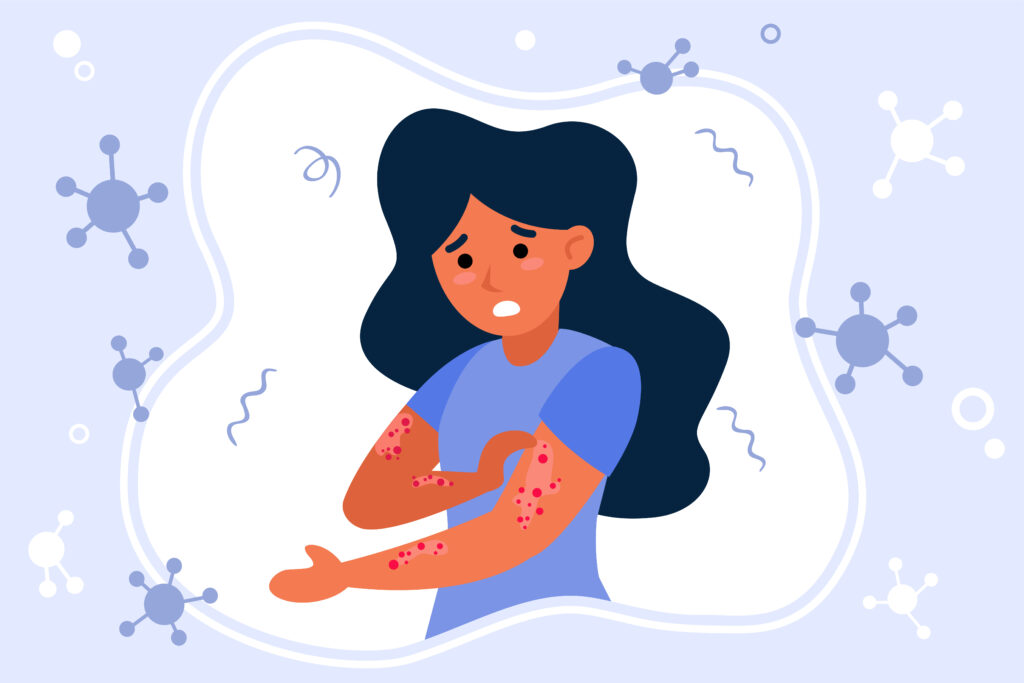What is Scabies?
Scabies is a skin condition caused by tiny mites called Sarcoptes scabiei. These mites burrow into the skin and cause intense itching. Scabies spreads easily through close contact. Because of this, outbreaks can happen in homes, schools, and care centers. The Centers for Disease Control and Prevention (CDC) notes that scabies affects people of all ages worldwide. Early treatment helps prevent scabies outbreaks and stops the spread.
Symptoms of Scabies
Scabies rash symptoms often appear two to six weeks after first exposure. However, symptoms may show up sooner if you have had scabies before. Common signs include:Intense itching, especially at nightRed bumps or blisters on the skinThin, wavy lines (burrows) on the skinSores from scratching
Usually, the rash appears between fingers, on wrists, elbows, waist, or around the genitals. But, scabies can affect any part of the body. In children, the face, scalp, and neck may also be involved. If you notice these symptoms, it is important to seek help.
Causes and Risk Factors
Scabies is caused by mites that move from person to person through close contact. For example, shaking hands, hugging, or sharing bedding can spread scabies. The risk increases in crowded places, such as nursing homes or schools. Some risk factors include:Living in crowded conditionsSharing clothes, towels, or beddingHaving a weak immune systemClose contact with someone who has scabies
Pets do not spread human scabies. However, it is important to treat everyone in the household to prevent reinfection.
How Scabies is Diagnosed
Doctors usually diagnose scabies by looking at your skin and asking about symptoms. Sometimes, they may gently scrape the skin to check for mites or eggs under a microscope. This test helps confirm the diagnosis. If you think you have scabies, it is best to see a healthcare provider. Early diagnosis can help stop scabies outbreaks in your area.
Treatment Options for Scabies
Scabies treatment usually involves prescription creams or lotions. These medicines kill the mites and their eggs. Common treatments include:Permethrin creamBenzyl benzoate lotionSulfur ointmentCrotamiton creamOral ivermectin (for severe cases)
Apply the medicine to the whole body, not just the rash. Leave it on for the time your doctor suggests. Sometimes, itching may last for weeks even after treatment. In that case, your doctor may recommend soothing creams or antihistamines. For best results, treat all close contacts at the same time. This helps prevent scabies from coming back. If you wonder how to treat scabies at home, always follow your doctor’s advice and do not use home remedies without guidance.
Prevention Tips
Preventing scabies outbreaks is possible with a few simple steps. After treatment, you should:Wash all clothes, bedding, and towels in hot waterDry items on a hot setting or seal them in a plastic bag for at least 3 daysAvoid close contact with infected people until treatment is completeClean and vacuum your home, especially bedrooms and living areas
In the US, following these steps can help stop scabies from spreading in your community. Also, remind family members and roommates to check for symptoms.
When to See a Doctor
If you have a rash that itches, especially at night, you should see a doctor. Additionally, if you notice burrows or blisters, seek medical advice. Early treatment can prevent scabies from spreading to others. If you have tried over-the-counter creams and the rash does not improve, talk to your healthcare provider. People with weak immune systems or young children should get help right away.
If you suspect you have scabies, consult a healthcare professional for personalized advice. Itching that won’t stop? Don’t ignore the signs. Visit Shilp Hospital for safe, effective treatment of scabies and protect your family from its spread

